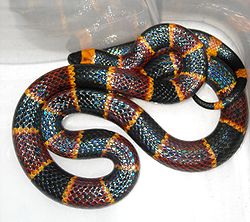Coral snake
The coral snakes are a large group of elapid snakes. There are two main groups of coral snakes. These groups are Old World coral snakes and New World coral snakes.
- There are 11 species of Old World coral snake in one genus (Calliophis)
- There are over 65 recognized species of New World coral snakes in three genera (Leptomicrurus, Micruroides, and Micrurus).
| Coral snake | |
|---|---|

| |
| Coral snake (Micrurus sp.) | |
| Scientific classification | |
| Kingdom: | Animalia |
| Phylum: | Chordata |
| Class: | Reptilia |
| Order: | Squamata |
| Superfamily: | Elapoidea |
| Family: | Elapidae |

Coral snakes have notable red, yellow/white, and black colored banding. Most species of coral snake are small. North American species average around 3 feet (91 cm) in length, but specimens of up to 5 feet (150 cm) or slightly larger have been reported. Coral snakes that live in water have flat tails. These tails act like a fin to help the snake swim.
Like all elapid snakes, coral snakes have a pair of small fangs to deliver their venom (some coral snakes are rear fanged). These fangs, which are enlarged and hollow, deliver their venom to their prey species. Coral snakes mostly eat smaller snakes, lizards, frogs, and nestling birds and rodents, etc. The venom takes time to take full effect.[1]
Coral snakes often hold on to a victim when biting, unlike vipers. Vipers have retractable fangs and tend to prefer to strike and let go immediately. Coral snakes are not aggressive or prone to biting. They account for less than one percent of the number of snake bites each year in the United States.
Coral snakes in the U.S.A.
New World coral snakes live in the southern range of many temperate U.S. states. They are found in the southern coastal plain from North Carolina to Louisiana, including all of Florida.[2]
There is debate about whether the Texas coral snake is a separate species. Its habitat, in Texas, Louisiana, and Arkansas, is separated from the eastern habitat by the Mississippi River. The coral snake population is most dense in the southeast United States, but coral snakes have been spotted as far north as Kentucky.[3]
The Arizona coral snake, which is a separate genus, is found in central and southern Arizona, extreme southwestern New Mexico and southward to Sinaloa in western Mexico. It lives in dry regions in thornscrub, desert-scrub, woodland, grassland and farmland. It is found in the plains and lower mountain slopes from sea level to 5800 feet (1768 m); often in rocky areas.[4]
Coral Snake Media
References
- ↑ "Coral Snakes, coral snake, pictures". Archived from the original on 29 September 2018. Retrieved 24 November 2009.
- ↑ "University of Georgia, Savannah River Ecology, Snakes of Georgia and South Carolina". Archived from the original on 2009-01-12. Retrieved 2013-07-15.
- ↑ "Western Connecticut State University". Archived from the original on 2007-09-28. Retrieved 2013-07-15.
- ↑ Arizona-Sonora Desert Museum

